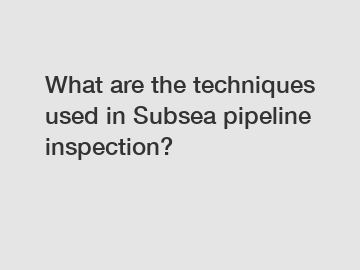What are the techniques used in Subsea pipeline inspection?
What are the techniques used in Subsea pipeline inspection?
Subsea pipeline inspection is a critical part of maintaining the integrity and safety of offshore pipeline systems. There are several techniques that are commonly used in subsea pipeline inspection to ensure that the pipelines are in good condition and free from any defects or damage.
One of the most common techniques used in subsea pipeline inspection is visual inspection. This involves using underwater cameras to capture high-resolution images of the pipeline, which can then be reviewed by trained inspectors. Visual inspection allows inspectors to identify any visible damage or anomalies on the pipeline, such as dents, corrosion, or leaks. This technique is essential for detecting surface defects that could potentially lead to more serious issues if left unattended.

Another technique used in subsea pipeline inspection is acoustic inspection. This involves using acoustic sensors to detect any abnormalities in the sound waves that are emitted by the pipeline. By analyzing these sound waves, inspectors can detect any areas of the pipeline that may be experiencing corrosion, erosion, or other structural issues. Acoustic inspection is particularly useful for detecting defects that may not be visible to the naked eye.
In addition to visual and acoustic inspection, subsea pipeline inspection also often involves the use of magnetic flux leakage (MFL) inspection. This technique uses magnetic sensors to detect any changes in the magnetic field around the pipeline, which can indicate the presence of defects such as corrosion or metal loss. MFL inspection is highly effective at detecting defects in the pipeline walls, making it an essential tool for ensuring the structural integrity of subsea pipelines.
Overall, the use of these techniques in subsea pipeline inspection is crucial for ensuring the safety and reliability of offshore pipeline systems. Regular inspections using these techniques can help to identify and address any issues before they escalate into more serious problems, reducing the risk of accidents and ensuring the continued efficient operation of subsea pipelines. By employing a combination of visual, acoustic, and magnetic inspection techniques, operators can effectively monitor the condition of their pipelines and take proactive measures to address any potential issues, ultimately minimizing downtime and maximizing the lifespan of the pipelines.
Contact us to discuss your requirements of China Subsea Pipeline Testing Offshore Pipeline Inspection, Sub-sea Pipeline Testing News, Sub-sea Pipeline Testing Service Supplier. Our experienced sales team can help you identify the options that best suit your needs.



Comments
0